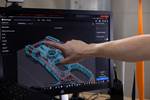Markforged Simulation software features virtual testing capability
Virtual testing validates the strength of advanced composite parts and automatically optimizes print parameters to help lower cost and speed production.
Share
Read Next
Markforged (Watertown, Mass., U.S.) has released new Simulation features for its additive manufacturing (AM) software, which is used to develop advanced composite parts. Simulation, which works within the company’s Eiger software slice and print workflow, is available as a free trial until April 2023, and the company expects to make the feature accessible through a paid subscription thereafter.
An added feature is virtual testing, which Markforged says will replace slow and costly design/print/break testing cycles, enabling manufacturers to expand their use of AM into the most demanding production applications. Using Simulation, the company says that any user can validate part strength and stiffness through virtual testing by identifying anchor and load surfaces and then entering values for loads, factor of safety and maximum deflection. They can then optimize parts by automatically determining print settings for floors, walls, infill and fiber reinforcement to achieve print cost and speed goals while maintaining adequate strength.
“Simulation enables our customers to adopt The Digital Forge deeper into their manufacturing operations by replacing more mission-critical tooling and end-use metal parts with validated and optimized 3D-printed advanced composite parts with continuous fiber reinforcement,” Shai Terem, president and CEO of Markforged, says. “Cloud-based software innovation like Simulation is core to our mission to bring industrial part production to the point of need.”
Markforged refers to a customer, Larsen Motorsports (Palm Bay, Fla., U.S.), which builds jet engine drag racing vehicles that reach more than 280 miles per hour. The company used Simulation to design and print a continuous carbon fiber-reinforced Onyx steering wheel strong enough to replace aluminum. “We can now test it with Simulation, iterate and keep iterating until we get a design we're happy with,” Brian Tocci, director of operations, Larsen Motorsports, says. “We don’t have to print ten different parts. We can do it all in Simulation.”
Related Content
-
McLaren celebrates 10 years of the McLaren P1 hybrid hypercar
Lightweight carbon fiber construction, Formula 1-inspired aerodynamics and high-performance hybrid powertrain technologies hallmark this hybrid vehicle, serve as a springboard for new race cars.
-
Plant tour: Teijin Carbon America Inc., Greenwood, S.C., U.S.
In 2018, Teijin broke ground on a facility that is reportedly the largest capacity carbon fiber line currently in existence. The line has been fully functional for nearly two years and has plenty of room for expansion.
-
Bio-based acrylonitrile for carbon fiber manufacture
The quest for a sustainable source of acrylonitrile for carbon fiber manufacture has made the leap from the lab to the market.














